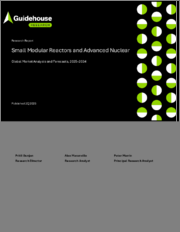
소형 모듈 원자로(SMR)는 에너지 수요의 가속화, 특히 유연하고 안정적인 전력, 에너지 시스템의 탈탄소화로의 지속적인 전환이 촉매제가 되어 향후 10년간 그 역할이 확대될 것으로 보입니다. 풍력과 태양광이 에너지 포트폴리오에서 차지하는 비중은 점점 커지고 있지만, 이러한 간헐적인 에너지원은 근본적인 제약이 있습니다. 배터리는 단기적인 에너지 저장을 제공할 수 있지만, 비용이 많이 들고 시간이 지남에 따라 성능이 저하됩니다. 반면, SMR은 일년 내내 최소한의 유지보수로 24시간 365일 깨끗한 고정 전력을 공급할 수 있으며, SMR은 확장성이 있어 수요에 따라 모듈을 쌓아 올릴 수 있습니다. AR(Advanced Furnace) 기술은 산업 수준의 열 생산, 신속한 가동 및 가동 중단의 유연성, 대형 배터리와 같은 에너지 저장과 같은 추가 사용 사례를 추가할 수 있습니다.
이 보고서는 2025년부터 2034년까지 SMR의 용량 증가와 수익 예측을 제시하고, 이 기술의 주요 촉진요인과 억제요인에 대해 조사분석하여 전해드립니다. 예측은 세계 지역별(북미, 유럽, 아시아태평양, 라틴아메리카, 중동 및 아프리카), 기술 유형별, 규모별, 입지별, 원자로 세대별로 구분되어 있습니다. 용량은 메가와트, 매출액은 2025년 기준 달러(USD)로 제공됩니다. 수익은 원자로 입지, 기기 및 부품 조달, 건설 관련 초기 비용, 운전, 유지보수, 연료비를 의미합니다. 원자로의 크기에는 큰 편차가 있고, 재고 SMR의 수가 한정되어 있기 때문에 예측은 어느 해에도 큰 편차가 있습니다. 원자로 용량 수치는 10,000회 반복된 각 연도의 평균값이기 때문에 파이프라인에 있는 특정 원자로 용량에 합산되지 않을 수 있습니다.
Small modular reactors (SMRs) may play an increasing role in the next decade, catalyzed by accelerated energy demand, particularly firm power with flexibility, and the continuing transition to decarbonize the energy system. While wind and solar are a growing proportion of the energy portfolio, there are fundamental constraints to these intermittent energy sources. Batteries can provide short term energy storage but are expensive and degrade over time. Conversely, SMRs enable 24/7 clean firm power, with minimal maintenance throughout the year. SMRs are scalable, comprised of modules that can be stacked together to match demand. Advanced reactor (AR) technology may have added use cases, such as producing industrial-level heat, flexibility to ramp up and down quickly, and even store energy like a large battery.
This report provides forecasts for SMR capacity additions and revenue from 2025 to 2034, and explains the technology's primary drivers and barriers. Forecasts are segmented by global regions (North America, Europe, Asia-Pacific, Latin America, Middle East & Africa), as well as technology type, size, location, and reactor iteration. Capacity is in megawatts of electricity, and revenue is in 2025 U.S. dollars. Revenue refers to the upfront costs associated with the reactor's siting, equipment and components procurement, and construction, as well as operation, maintenance, and fuel costs. The forecast has a high variance in any given year because of the large variance in reactor size and the limited number of SMRs in the inventory. The capacity number is the average of what happens in each year across 10,000 iterations, so numbers may not total to specific reactor capacities in the pipeline.